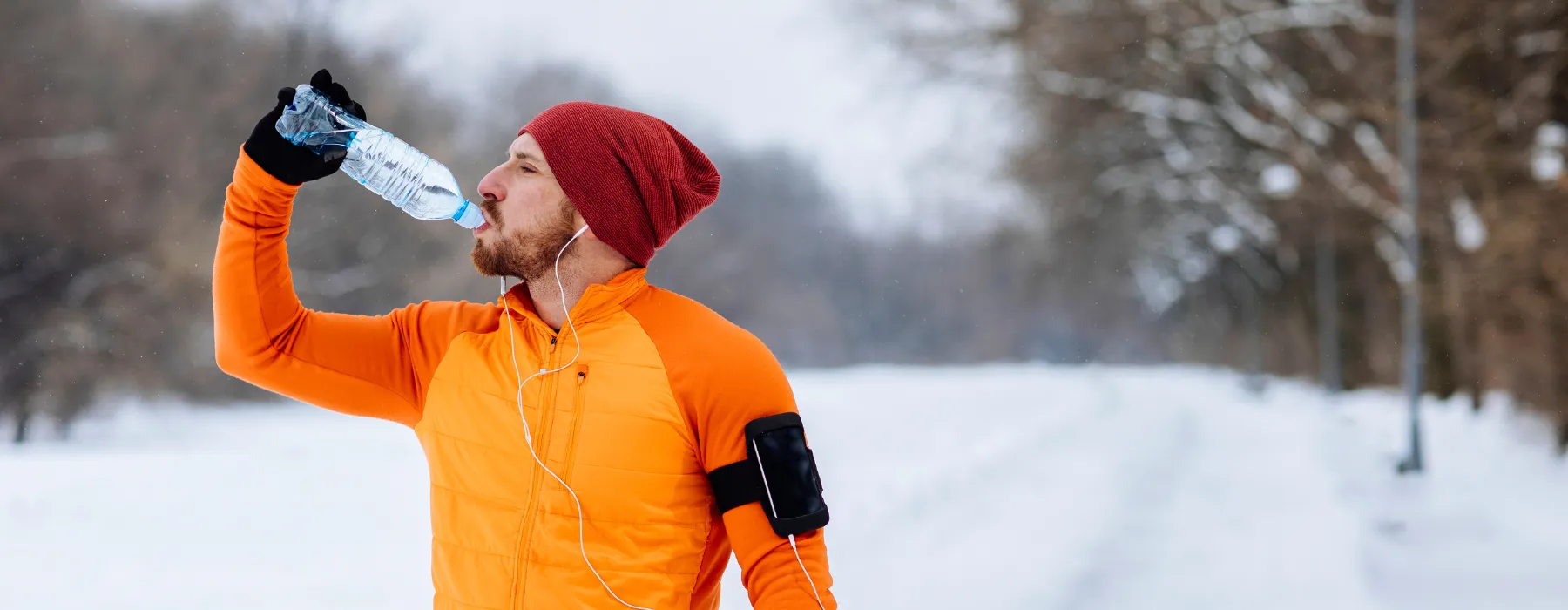Winter runners are tough. Facing the cold and enduring the elements takes drive—and it takes hydration!
One of the most dangerous elements of freezing temperatures is that it masks thirst. That’s why it’s essential to be intentional about bringing water with you on your run, even when it’s challenging.
Check out our best tips for staying hydrated below, and be safe out there this winter!
Tip #1: Drink water before, during, and after your run.
Hydration is more than just an in-the-moment thing; it’s an all-day endeavor. Before starting your run, you should drink at least 500mL of water; as you run, sip continually; and after you’re finished, have another 500mL.
Tip #2: Stick with room-temperature water or warm liquids.
Ice cold water may be refreshing, but in winter, it makes it harder for your body to stay at an optimal temperature while outside. Before and during your run, reach for room temperature water or other warm beverages (such as tea or broth) to keep your hydration levels up.
Tip #3: Invest in insulated water bottles.
Cold air will quickly cool down your warm drinks (or even freeze your water!), but using an insulated water bottle will ensure that your drinks stay the temperature you desire. We recommend this 12oz handheld insulated water bottle from Nathan, which is easy to carry and sip from while on the move.
One thing we DON’T recommend for winter is hydration backpacks with tubes to drink from, as these are especially susceptible to freezing.
Tip #4: Mix in some electrolytes.
Especially on longer runs, adding electrolytes can make a big difference in your energy. You can either get electrolyte drinks or mix electrolyte tablets or powders into your usual water. Either way, you’ll see a boost in hydration that will help keep you feeling good.
Tip #5: Eat sodium- and water-rich foods.
As you anticipate your run, try and consume foods that will keep you hydrated. Water-based foods will get the liquids in, while sodium-based foods will help your body retain those fluids.
- Water-based foods: melons, cucumbers, apples, celery, brothy soups
- Sodium-rich foods: soups, pretzels, nuts, pickles
Tip #6: Dress to stay warm and reduce excess sweat.
Dressing for winter running can be tricky, as it’s easy to either over-layer or under-layer. Here’s our approach to maintaining a comfortable temperature in the cold:
For your upper body, we recommend three layers:
- A moisture-wicking base layer to pull sweat and moisture away from your skin.
- A soft, insulating middle layer to keep you warm.
- A waterproof and windproof outer layer to shield you from the elements.
For your lower body, go for high-quality leggings, tights, or windproof pants. If the temperature is close to freezing or below, layering both options provides extra protection.
We also suggest minimizing exposed skin. Hats, headbands, neck gaiters, gloves, and socks will help keep you warm and protected.
All of this will work together to make sure you’re not losing too much or too little liquid to sweat as you run, keeping your hydration levels stable.
Explore our full selection of women’s running apparel and men’s running apparel here—Goodmiles has everything you need!
Stay in Touch with Goodmiles Running Company
For tips and tricks to optimize your run year-round, Goodmiles Running Company is the place to go. Our blog is full of helpful advice on a range of topics—from the best shoes, to safety, to training, and beyond—while our team of Fit Experts is available in-store seven days a week to answer any questions you may have.
Stay safe, hydrated, and warm out there, running buddies!
